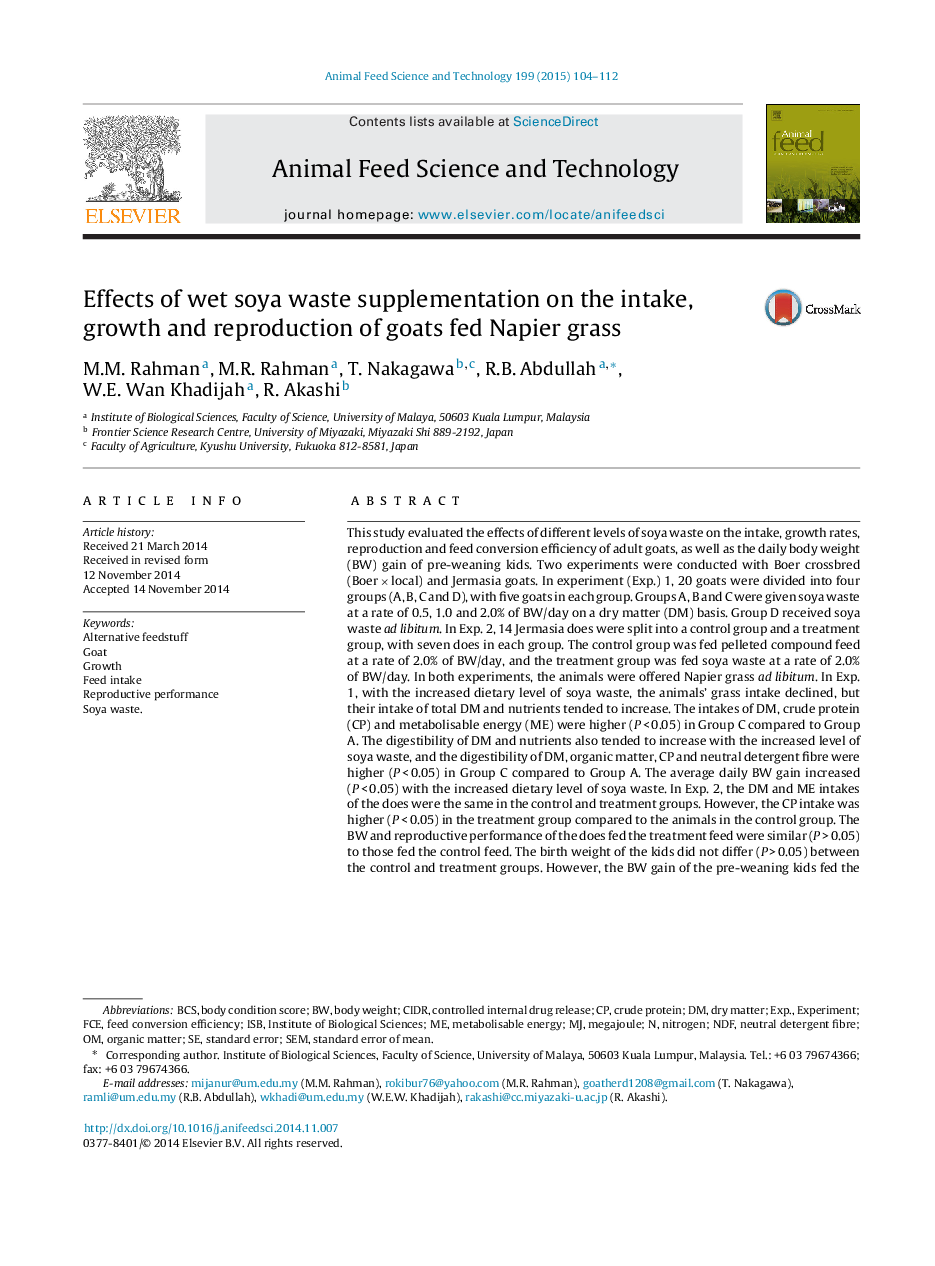| کد مقاله | کد نشریه | سال انتشار | مقاله انگلیسی | نسخه تمام متن |
|---|---|---|---|---|
| 8491439 | 1552386 | 2015 | 9 صفحه PDF | دانلود رایگان |
عنوان انگلیسی مقاله ISI
Effects of wet soya waste supplementation on the intake, growth and reproduction of goats fed Napier grass
ترجمه فارسی عنوان
تأثیر مکمل های خوراکی سویا مرطوب بر مصرف، رشد و تولید مثل بز های چمن نپیر
دانلود مقاله + سفارش ترجمه
دانلود مقاله ISI انگلیسی
رایگان برای ایرانیان
کلمات کلیدی
megajouleFCENDFCIDRstandard error of mean.ISBExp. - ExpExperiment - آزمایش یا تجربهmetabolisable energy - انرژی قابل متابولیسمFeed conversion efficiency - بازده تبدیل خوراکGoat - بزstandard error - خطای استانداردGrowth - رشدBCs - روند BCsReproductive performance - عملکرد تولید مثلneutral detergent fibre - فیبر مواد شوینده خنثیorganic matter - ماده آلیdry matter - ماده خشکSEM - مدل معادلات ساختاری / میکروسکوپ الکترونی روبشیFeed intake - مصرف غذاBody condition score - نمره وضعیت بدنNitrogen - نیتروژنbody weight - وزن بدنcrude protein - پروتئین خامControlled internal drug release - کنترل داروی آزاد داروی داخلی
موضوعات مرتبط
علوم زیستی و بیوفناوری
علوم کشاورزی و بیولوژیک
علوم دامی و جانورشناسی
چکیده انگلیسی
This study evaluated the effects of different levels of soya waste on the intake, growth rates, reproduction and feed conversion efficiency of adult goats, as well as the daily body weight (BW) gain of pre-weaning kids. Two experiments were conducted with Boer crossbred (Boer Ã local) and Jermasia goats. In experiment (Exp.) 1, 20 goats were divided into four groups (A, B, C and D), with five goats in each group. Groups A, B and C were given soya waste at a rate of 0.5, 1.0 and 2.0% of BW/day on a dry matter (DM) basis. Group D received soya waste ad libitum. In Exp. 2, 14 Jermasia does were split into a control group and a treatment group, with seven does in each group. The control group was fed pelleted compound feed at a rate of 2.0% of BW/day, and the treatment group was fed soya waste at a rate of 2.0% of BW/day. In both experiments, the animals were offered Napier grass ad libitum. In Exp. 1, with the increased dietary level of soya waste, the animals' grass intake declined, but their intake of total DM and nutrients tended to increase. The intakes of DM, crude protein (CP) and metabolisable energy (ME) were higher (P < 0.05) in Group C compared to Group A. The digestibility of DM and nutrients also tended to increase with the increased level of soya waste, and the digestibility of DM, organic matter, CP and neutral detergent fibre were higher (P < 0.05) in Group C compared to Group A. The average daily BW gain increased (P < 0.05) with the increased dietary level of soya waste. In Exp. 2, the DM and ME intakes of the does were the same in the control and treatment groups. However, the CP intake was higher (P < 0.05) in the treatment group compared to the animals in the control group. The BW and reproductive performance of the does fed the treatment feed were similar (P > 0.05) to those fed the control feed. The birth weight of the kids did not differ (P > 0.05) between the control and treatment groups. However, the BW gain of the pre-weaning kids fed the treatment feed was higher (P < 0.05) than that of the pre-weaning kids fed the control feed. Based on this 14-month long feeding study, high levels of soya waste (up to 2.0% DM of BW) did not have detrimental effects on the feed intake, weight gain and reproductive performance of goats, suggesting that soya waste supplementation is a viable replacement for scarce feedstuffs, such as grass, and expensive commercially produced compound feed.
ناشر
Database: Elsevier - ScienceDirect (ساینس دایرکت)
Journal: Animal Feed Science and Technology - Volume 199, January 2015, Pages 104-112
Journal: Animal Feed Science and Technology - Volume 199, January 2015, Pages 104-112
نویسندگان
M.M. Rahman, M.R. Rahman, T. Nakagawa, R.B. Abdullah, W.E. Wan Khadijah, R. Akashi,
